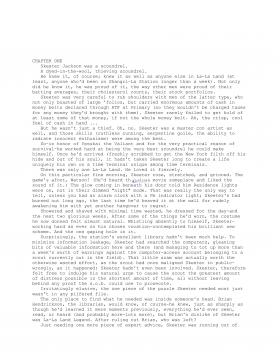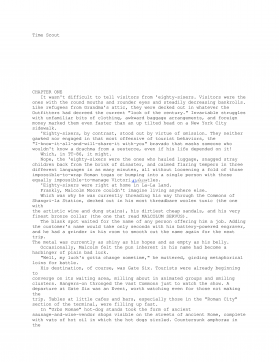as it did by daylight. Just inexplicably deserted. My carriage on the train had been empty, too.
Last-human-on-Earth time.
Birds were calling-loudly-in the lush bushland which lined the railway corridor, and in the
labyrinth of wooded parks woven into the surrounding suburb. Many of the parks resembled pristine
forest-but every tree, every shrub was engineered: at the very least drought and fire resistant,
shedding no messy, flammable twigs, bark or leaves. Dead plant tissue was resorbed, cannibalized;
I'd seen it portrayed in time-lapse (one kind of photography I never carried out myself): an
entire brown and wilting branch shrinking back into the living trunk. Most of the trees generated
a modest amount of electricity-ultimately from sunlight, although the chemistry was elaborate, and
the release of stored energy continued twenty-four hours a day. Specialized roots sought out the
underground superconductors snaking through the parks, and fed in their contributions. Two and a
quarter volts was about as intrinsically safe as electric power could be-but it required zero
resistance for efficient transmission.
Some of the fauna had been modified, too; the magpies were docile even in spring, the mosquitoes
shunned mammalian blood, and the most venomous snakes were incapable of harming a human child.
Small advantages over their wild cousins, tied to the biochemistry of the engineered vegetation,
guaranteed the altered species dominance in this microecology-and small handicaps kept them from
flourishing if they ever escaped to one of the truly wild reserves, distant from human habitation.
10
I was renting a small detached unit in a cluster of four, set in a zero-maintenance garden which
merged seamlessly with the tendril of parkland at the end of a cul-de-sac. I'd been there for
eight years, ever since my first commission from SeeNet, but I still felt like a trespasser. East-
wood was just eighteen kilometers from the center of Sydney, which- although ever fewer people had
reason to travel there-still seemed to hold an inexplicable sway over real-estate prices; I
couldn't have bought the unit myself in a hundred years. The (barely) affordable rent was just a
felicitous by-product of the owner's elaborate tax evasion schemes-and it was probably only a
matter of time before some quiver of butterfly wings in world financial markets rendered the
networks slightly less generous, or my landowner slightly less in need of a write-off, and I'd be
picked up and flung fifty kilometers west, back to the outer sprawl where I belonged.
I approached warily. Home should have felt like a sanctuary after the night's events, but I
hesitated outside the front door, key in hand, for something like a minute.
Gina was up, dressed, and in the middle of breakfast. I hadn't seen her since the same time the
day before; it was as if I'd never left.
She said, "How was filming?" I'd sent her a message from the hospital, explaining that we'd
finally got lucky.
"I don't want to talk about it." I retreated into the living room and sank into a chair. The
action of sitting seemed to replay itself in my inner ears; I kept descending, again and again. I
fixed my gaze on the pattern in the carpet; the illusion slowly faded.
"Andrew? What happened?" She followed me into the room. "Did something go wrong? Will you have to
reshoot?"
"I said I don't want to-" I caught myself. I looked up at her, and forced myself to concentrate.
She was puzzled, but not yet angry. Rule number three: Tell her everything, however unpleasant, at
the first opportunity. Whether you feel like it or not. Anything less will be treated as
deliberate exclusion and taken as a personal affront.
I said, "I won't have to reshoot. It's over." I recounted what had happened.
Gina looked ill. "And was anything he said worth . . . extracting? Did mentioning his brother make
the slightest sense or was he just braindamaged and ranting?"
"That's still not clear. Evidently the brother does have a history of violence; he was on
probation for assaulting his mother. They've taken
11
him in for questioning . . . but it could all come to nothing. If the victim's short-term
memories were lost, he could have pieced together a false reconstruction of the stabbing, using
the first person who came to mind as being capable of the act. And when he changed his story he
might not have been covering up at all; he might simply have realized that he was amnesic."
Gina said, "And even if the brother did kill him ... no jury is going to accept a couple of words,
instantly retracted, as any kind of proof. If there's a conviction, it will have nothing to do
with the revival."
It was difficult to argue the point; I had to struggle to regain some perspective.
"Not in this case, no. But there have been times when it's made all the difference. The victim's
word alone might never stand up in court- but there've been people tried for murder who would
never have been suspected otherwise. Cases when the evidence which actually convicted them was
file:///F|/rah/Greg%20Egan/Egan,%20Greg%20-%20Distress.txt (5 of 157) [1/23/03 12:28:37 PM]

 2024-12-08 12
2024-12-08 12
 2024-12-08 14
2024-12-08 14
 2024-12-08 10
2024-12-08 10
 2024-12-08 10
2024-12-08 10
 2024-12-08 15
2024-12-08 15
 2024-12-08 18
2024-12-08 18
 2024-12-08 27
2024-12-08 27
 2024-12-08 25
2024-12-08 25
 2024-12-08 16
2024-12-08 16
 2024-12-08 30
2024-12-08 30








 渝公网安备50010702506394
渝公网安备50010702506394
